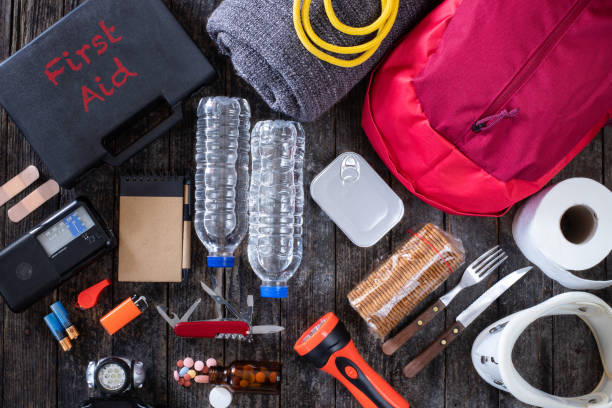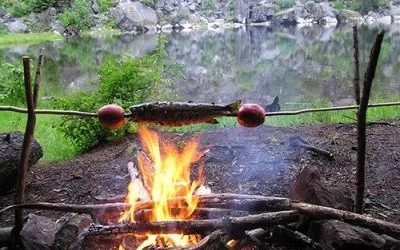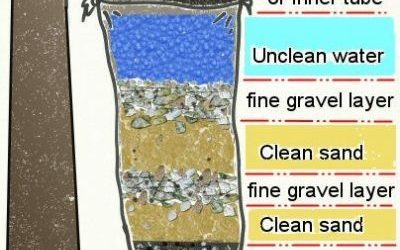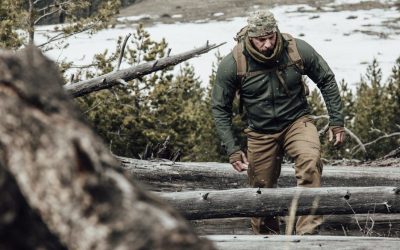Being prepared is essential for survival. A survival kit is a collection of materials and equipment meant to assist you in surviving an emergency. Having the correct equipment and materials on hand may make all the difference in a natural catastrophe, wilderness survival crisis, or any other form of emergency. This blog post will go over ten vital items that should be included in any survival kit. These products will help you stay safe and self-sufficient in any emergency circumstance, from first aid supplies and navigation tools to shelter and water purification equipment.
Water
It is critical for survival to have access to clean, safe drinking water. Consider adding a water bottle, a water filter or purification tablets, and a hydration system to your kit (such as a hydration pack or water bladder).
In any emergency circumstance, having access to clean, safe drinking water is critical for survival. Your body can soon become dehydrated if you do not drink enough water, which can lead to major health concerns such as heat stroke, kidney damage, and even death. In case of an emergency, it’s important to have a plan for getting and cleaning water.
Carrying a water bottle or hydration system with you at all times is one way to guarantee you have access to clean drinking water. A water bottle or hydration pack stores and transports water effortlessly and may be replenished as needed. A water filter or purification device is also an excellent addition to your survival pack. Water filters are intended to remove pollutants from water such as bacteria, viruses, and sediment, making it safe to drink. Purification pills, on the other hand, destroy pollutants in water by using chemicals. Both techniques can purify water effectively, but it is critical to follow the manufacturer’s recommendations and change the filter or tablets as needed.
In addition to having a water bottle or hydration system, knowing how to obtain and filter water in the outdoors is essential. Water may be purified in a variety of ways, including boiling, filtering, and utilizing purification tablets. It is also a good idea to understand how to locate water sources in the wilderness, such as rivers, lakes, and streams. If you’re in a survival situation and don’t have a water bottle or hydration device, you may need to locate and filter water utilizing natural resources.
Overall, access to safe drinking water is critical for survival. Carrying a water bottle or hydration system, as well as understanding how to source and filter water, helps guarantee that you have the hydration you need in any emergency circumstance.
Food
Pack non-perishable, high-energy items that are easy to travel with and store, such as energy bars, almonds, and dried fruits.
In any emergency circumstance, having a stock of non-perishable, high-energy meals on hand is critical for life. These foods are easy to store, carry, and consume, and they may supply the nutrition your body requires to stay strong and healthy.
When preparing food for a survival emergency, it is critical to select non-perishable products with a lengthy shelf life. Non-perishable foods do not deteriorate readily and may be kept at room temperature for long periods of time. Energy bars, almonds, dried fruits, jerky, and granola are examples of non-perishable foods. These meals are simple to pack and travel with, and they may provide a rapid supply of energy when needed.
Aside from being non-perishable, it is also critical to select high-energy meals that are high in nutrients and calories. These foods will offer your body the nutrition it requires to function correctly and will keep you going in a survival emergency. Nuts, for example, are high in protein and healthy fats, and they can help you feel full and pleased. Dried fruits are abundant in calories and minerals, as well as being convenient to carry and consume on the go.
It is also a good idea to have a range of meals in your survival kit to guarantee a well-balanced diet. This can help you avoid boredom while also ensuring that you obtain the nutrients you need to be healthy. Protein bars, canned foods, and dry soup mixes are among other items to consider carrying.
In general, having a stockpile of non-perishable, high-energy meals on hand is critical for survival in any emergency circumstance. You can guarantee that you have the fuel you need to be strong and healthy in any scenario by bringing a range of non-perishable, nutrient-rich meals.
Shelter
Shelter is a tiny, lightweight tarp or tent that may be used to provide a temporary shelter and give protection from the weather.
A shelter is crucial for survival in any emergency circumstance because it protects you from the elements and keeps you safe and comfortable. A modest, lightweight tarp or tent may be a handy addition to your survival pack because it is portable and easy to set up in a number of situations.
A tarp is a lightweight, flexible, waterproof sheet that may be used to make a temporary shelter. When not in use, it is frequently constructed of plastic or nylon and may be simply rolled up and stored. Tarps are adaptable and may be used in a variety of ways, such as for building a rain-proof roof or wall, or as a ground cover to keep you dry and warm. They are also reasonably priced and can be bought at most sporting goods or camping stores.
In a survival crisis, another option for making a temporary shelter is a tent. Tents are available in a variety of sizes and types, and may be used to provide a more permanent shelter for extended periods of time. Many tents are composed of lightweight, waterproof fabrics that are easy to transport and set up in a variety of settings. Tents, which offer a fully enclosed room that may be used to sleep, cook, or store stuff, can offer more protection from the weather than tarps.
When selecting a tarp or tent for your survival kit, consider the product’s size, weight, and durability. A lightweight, compact tarp or tent will be easier to transport and put up, taking up less room in your survival gear. It is also important to choose a product that is made of high-quality, waterproof materials. This will make sure that it can withstand harsh weather and protect you as needed.
Overall, a small, light tarp or tent could save your life in a survival situation by protecting you from the elements and keeping you safe and comfortable.
First aid kit
Bandages, antiseptic wipes, painkillers, and anything else you might need in case of an injury or illness should be in a basic first aid bag for a survival situation.
A first aid kit is a collection of goods and equipment used to give medical care in an emergency. Having a first aid kit on hand is especially important when traveling or doing outdoor activities, in case of accidents or illnesses.
The contents of a basic survival first aid kit may vary based on the individual’s needs and activities. Certain things, however, are typically suggested to be included in any first aid kit.
The following are some examples of items that may be included in a basic first aid kit:
Bandages are used to protect and cover wounds. A first aid kit should include a variety of bandages, such as adhesive bandages (commonly known as Band-Aids), gauze pads, and elastic bandages (such as Ace wraps).
Antiseptic wipes: These are used to clean and disinfect wounds in order to keep infections at bay. Antiseptic wipes are useful since they do not require the use of water to clean the wound.
Pain relievers, such as acetaminophen or ibuprofen, can be included in a first aid pack to help with pain and inflammation. When taking any medicine, it is critical to follow the specified dose guidelines.
More things: Depending on the needs of the individual utilizing the first aid kit, many other items may be included. Tweezers for removing splinters or ticks, scissors for cutting bandages or garments, safety pins for attaching bandages, and a thermometer for measuring temperatures are other examples. You might also want to include a first aid guidebook or other reference materials to help you give first aid.
It is critical to examine the contents of your first aid kit on a regular basis and replenish any goods that have been used or expired. It’s also a good idea to keep your first aid kit in a convenient and easy-to-reach area, so it’s ready to go in an emergency.
Knife
A good multi-purpose survival knife can be used for many different things, like cutting, carving, and making food.
A knife is a cutting instrument that is commonly used for a variety of tasks, such as food preparation, carving, and basic cutting. A high-quality multi-purpose knife is a must-have in every survival circumstance.
Fixed blade knives and folding knives are two of the various varieties of knives that may be used for survival. Fixed blade knives are often more robust and stronger than folding knives, but they are also bulkier and more difficult to carry. Folding knives, on the other hand, are smaller and simpler to transport, but they may not be as robust as fixed blade knives.
When choosing a survival knife, consider the sort of duties you will be performing with the knife. For example, if you intend to use the knife for food preparation, you should select one with a sharp, pointed blade capable of slicing through tough meats and vegetables. If you want to use the knife for carving or other chores that require more accurate cutting, you should select one with a finer, more tapered blade.
Aside from the type of blade, the material from which the blade is produced is also vital to consider. High-quality blades are frequently constructed of stainless steel or other long-lasting materials that resist corrosion and wear. It is also a good idea to select a knife with a comfortable, well-grip handle, as this will make it simpler to use the knife for extended periods of time.
Overall, a good-quality, multi-purpose knife is a must-have tool in any survival circumstance since it can be used for a variety of activities such as cutting, carving, and preparing meals. Choose a knife that fits your needs and is made of strong materials to make sure it can handle the stress of a survival situation.
Fire starter
A lighter or waterproof matches, for example, can be used to kindle a fire for warmth, cooking, or signaling for aid.
The ability to kindle a fire in a survival scenario can be critical for warmth, cooking, and signaling for aid. A fire starter is a tool used to start the combustion process and produce a flame. There are several different types of fire starters that may be used for survival, including lighters, waterproof matches, and flint and steel fire starters.
A lighter is a portable, handheld device that produces a flame by burning a fuel source such as butane. Lighters are easy to use and frequently tiny and portable, making them a common choice for a fire starter. They do, however, require a fuel source and may not function if the gasoline is exhausted or the lighter is destroyed.
Waterproof matches are another alternative for starting a fire. These matches are engineered to ignite even when wet, making them an excellent choice for usage in rainy or humid situations. Waterproof matches are often constructed from a specific type of paper that has been coated with a waterproof coating and come with a waterproof storage container.
Fire starters made of flint and steel are another option for starting a fire. These fire starters function by producing a spark that may be used to light dry leaves or twigs. Because they do not require a fuel source and are not impacted by damp circumstances, flint and steel fire starters are often more dependable than lighters or matches. They are, however, more difficult to use and may take considerable effort to master.
In order to start a fire, you must have tinder and kindling accessible in addition to a fire starter. Tinder is an easily lit item that may be used to start a fire, whereas kindling is a tiny, dry material that can be used to fuel the fire once it has been started. In a survival emergency, a fire starter, tinder, and kindling can be used together to build a fire for warmth, cooking, or signaling for aid.
Flashlight
In low-light circumstances, a flashlight or headlamp can offer illumination.
A flashlight, sometimes known as a headlamp, is a portable illumination device that may be used to give light in low-light circumstances. In a survival situation, a reliable source of light can help you find your way, identify and gather supplies, and do other things.
Flashlights are battery-powered portable devices with a light bulb that emits light when triggered. They are usually tiny and portable, making them simple to transport and utilize. Flashlights may be used to provide light in a variety of scenarios, including when the power goes out, when navigating in the dark, and when accomplishing work in low-light settings.
Another alternative for providing light in a survival situation is a headlamp. Headlamps are wearable lighting devices that are worn on the head and emit light in the direction of the user’s gaze. Headlamps are beneficial because they free up the user’s hands to perform chores, and they are also handy in circumstances where a flashlight would be inconvenient or difficult to handle.
When choosing a flashlight or headlamp for survival, it is critical to evaluate the type of batteries used, as well as the light’s brightness and beam distance. It’s also a good idea to choose a tool that is both strong and water-resistant, since it may be used in harsh or wet conditions during a survival situation.
Overall, a flashlight or headlamp could be a very useful tool in a survival situation. They provide light when it’s dark and let the user find their way, find and gather resources, and do things.
Compass and map
If you become lost in the bush, a map and compass can help you navigate and find your way.
In a survival situation, having the tools and resources essential to navigate and find your way if you become lost in the woods is critical. A map and compass are vital tools for accomplishing this.
A map is a depiction of a region that depicts its topography, features, and landmarks. Maps are available in a range of sizes and may be used to depict a small region in detail or a large area in a broad sense. In a survival situation, a map can help you find your way and figure out where you are. It can also help you plan your route and get to your destination.
A compass is an instrument for determining direction. It is made up of a magnetic needle that is fixed on a pivot point and may rotate freely. The needle is drawn to the earth’s magnetic field and will always point north, regardless of which way the compass is pointed. A compass and a map can be used together to help you identify your location and navigate to your destination.
It is critical to learn how to read and comprehend the information provided by a map and compass when using them together. To do this, you may need some experience and familiarity with the tools, as well as a basic understanding of how to navigate.
In addition to a map and compass, fundamental navigation skills, such as the ability to use natural landmarks and the sun to determine direction, are essential. A backup navigation tool, such as a GPS gadget, is also a smart idea in case your primary navigation equipment fails or is lost.
Overall, a map and compass are crucial tools for survival navigation and finding your way. If you get lost in the woods, they can help you find your bearings, figure out where you are, and find your way to your destination.
Emergency siren
If you are lost or injured, an emergency whistle can be used to alert aid.
An emergency whistle is a small, portable device that is used to summon help in an emergency. It is often part of a survival kit or a personal plan for being ready for an emergency.
An emergency whistle is meant to provide a loud, high-pitched sound that can be heard from a long distance. This might be important in a survival emergency if you are lost or injured and need to signal for aid. The sound of the whistle may attract the attention of rescuers or other people who are nearby and may be able to assist.
There are many different varieties of emergency whistles available, and they may be fashioned from a range of materials such as plastic, metal, or wood. Some emergency whistles have extra features that could be helpful in a survival situation, like a built-in compass or a signaling mirror.
When using an emergency whistle, it is necessary to blast it in quick, rapid bursts rather than one lengthy, continuous blow. This will help you save electricity while also ensuring that the whistle is as loud and clear as possible. It is also a good idea to practice using the whistle ahead of time so that you are familiar with how it works and can use it efficiently in an emergency.
Overall, an emergency whistle is a basic yet efficient weapon for signaling for aid in a survival scenario. It’s small, portable, and easy to use, which makes it a great addition to any survival kit or plan for getting ready for a disaster.
Multi-tool
A Leatherman or Swiss Army knife is a multi-tool that can be used for many things, like cutting, sawing, and opening containers.
A multi-tool is a small, portable tool that can do a range of tasks. Multi-tools are sometimes referred to by brand names such as Leatherman or Swiss Army knife, and they may be a vital resource in a survival emergency.
A multi-tool generally consists of a handle with a number of various tools connected to it. These tools may include a blade for cutting, pliers for grasping and bending, a screwdriver for tightening or loosening screws, and a saw for cutting through wood or other materials. Some multi-tools have extra features, like the ability to open cans, bottles, or cut wire.
The particular tools and functionality of a multi-tool will vary based on the model and manufacturer. Some multi-tools are designed for certain jobs or activities, but others are more general-purpose and may be used for a variety of tasks.
In a survival crisis, a multi-tool may be utilized for a variety of activities, such as cutting, sawing, and opening containers. It can also be used to fix or maintain things like a tent or a backpack, or to do other things that might be needed in an emergency.
When choosing a multi-tool for survival, it is critical to choose a tool that is both robust and well-made, as it may be subjected to harsh or demanding situations. It is also a good idea to select a tool that has a selection of tools and features that are appropriate for your needs and the tasks that you may experience in a survival situation.
Overall, a multi-tool is versatile and useful equipment to have in a survival situation.It may be used for a variety of jobs and can be a useful resource for completing work, maintaining equipment, and addressing other requirements that may occur during an emergency.
Summary
Remember to customize your survival pack to your unique needs and the sort of situation you may be facing. It’s a good idea to check on and update your kit on a regular basis to make sure it’s always full and ready to use.






